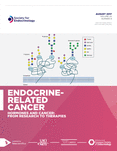WOMEN IN CANCER THEMATIC REVIEW: Ovarian cancer–peritoneal cell interactions promote extracellular matrix processing
- 1Discipline of Obstetrics and Gynaecology, Adelaide Medical School, Robinson Research Institute, University of Adelaide, Adelaide, South Australia, Australia
- 2Lung Research Laboratory, Hanson Institute, Department of Thoracic Medicine, Royal Adelaide Hospital, Adelaide, South Australia, Australia
- 3Department of Gynaecological Oncology, Royal Adelaide Hospital, Adelaide, South Australia, Australia
- Correspondence should be addressed to C Ricciardelli; Email: carmela.ricciardelli{at}adelaide.edu.au
-
Figure 1
(A) H&E section of a serous ovarian carcinoma implant in the omentum. Black arrow indicates the layer of mesothelial cells. White asterisk indicates the metastatic ovarian cancer cells. (B) Direct co-culture of mesothelial peritoneal cells (LP-9) with OVCAR-5 cells induces cell aggregation (black arrow) most evident after 96 h. (C) A monolayer of LP-9 cells was exposed to a suspension of OVCAR-5 or SKOV-3 cells for 48 h to mimic the in vivo situation of ovarian cancer metastasis and the CM collected, precipitated in acetone, and run on an SDS gel and stained with Coomassie blue. Selected bands present in either the single cell culture or the co-culture only were excisioned and analysed by mass spectrometry (Maldi TOF/TOF). Band 1 = fibronectin, Band 2 = fibronectin, Band 3 = periostin, Band 4 = TGFBI, Band 5 = PAI-1, Band 6 = CK-1, Band 7 = fibronectin, Band 8 = fibronectin.
-
Figure 2
Role of annexin A2 in the activation of the plasminogen–plasmin system. Annexin A2 with p11 protein (S100A10) forms an annexin A2 heterotetramer complex on the plasma membrane which co-localise with CD44, tenascin-C, cathepsin B and tissue plasminogen activator (t-PA). Annexin A2-mediated t-PA-dependent plasmin generation leads to the activation of growth factors, activation of proteases including MMPs, inactivation of proteases (PAI-1), degradation of extracellular matrix (ECM) proteins including fibronectin, TGFBI, periostin and annexin A2, which all act to increase cancer cell adhesion invasion, metastasis and tumour growth. Annexin A2 also increases cancer cell proliferation and cell survival via the ERK1/2 and MAPK pathway and plays a role in actin cytoskeletal rearrangement and regulates cancer cell migration.
- © 2016 Society for Endocrinology












